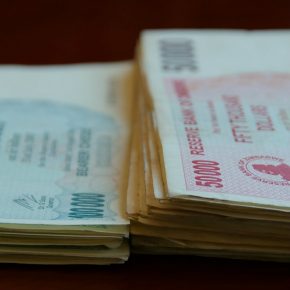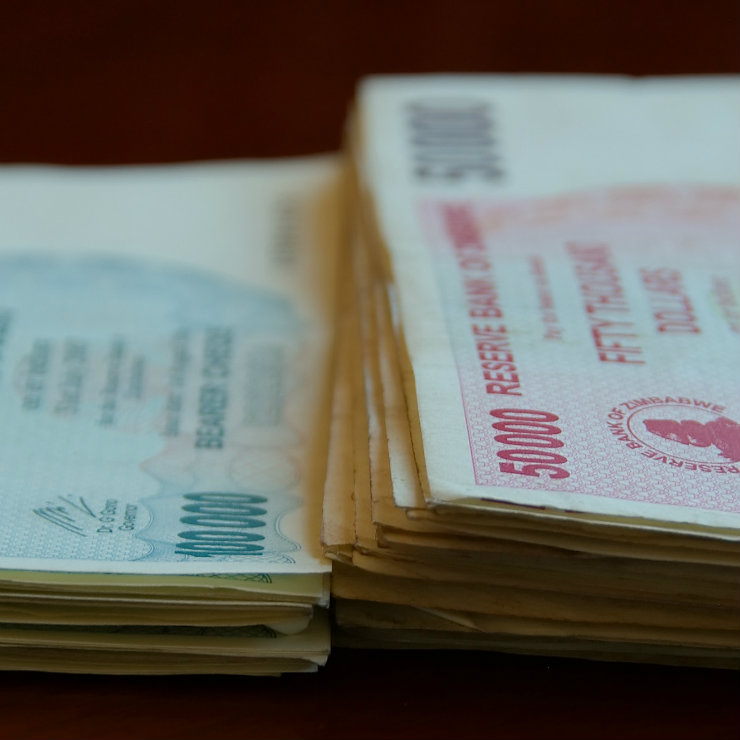
(david reid, CC BY-NC 2.0)
CE Financial Observer: Is there a yes-no answer to whether inflation is a positive phenomenon? Central bank policy always seeks to keep price growth positive, yet people on the street see rising prices as a curse.
Prof. Klaus Adam: There is no such answer. Inflation can be good, bad or neutral for economic growth, just like deflation. It all depends on the circumstances and what drives these phenomena.
Historically speaking, central banks used to fear inflation rather than deflation.
Indeed the past has taught us that uncontrolled inflation may have terrible consequences; statistically speaking, inflation poses a problem more often than deflation. Today, however, the situation has changed. Central banks are worried about inflation that is too low, i.e. one that is — at least in the developed economies — below the so-called inflation target, the optimal rate of price growth. And they are trying to change it.
Trying?
The effectiveness of their actions is difficult to assess unequivocally. The question is, what would have happened if the banks had done nothing — would inflation be lower, higher or the same as today — but you cannot answer such a question with any degree of certainty. The banks’ actions certainly affect the price level, but given the relatively short observation period, nothing can be said with certainty.
So you can’t say which of the central banks is the most effective in achieving the inflation target?
You can — if you take into account a longer period than the last few years, and look at major key currency areas, i.e. the USA, the European Monetary Union and Japan. The Federal Reserve of the USA (Fed) will then be the most effective. At least inflation in the USA today is the closest to the set target. Having said that, the initial optimism assuming that interest rates in the USA will stay significantly above zero has evaporated. Some even hint at a new rate cut. So it is clear that “closer” is still not close enough yet. If you look at the European Central Bank (ECB), as recently as in the second half of 2018 it was quite sure that it would meet the inflation target and siphon some liquidity which had expanded through quantitative easing off the market. But today this certainty is dwindling. Success, in terms of an appropriate level of inflation, is moderate.
The Bank of Japan has been struggling with below-target inflation for a long time. In fact, prices in Japan are standing still. Simultaneously, the economy is continuously being “stimulated” with ultra-low interest rates. Shouldn’t the decision-makers focus more on economic growth instead of price indices, which are only a derivative of this growth?
By striving for optimal inflation, you also strives for economic growth. Both require the same direction of action. Optimal inflation means growth, inflation below target means stagnation, and inflation above the target entails the need to tighten the monetary policy, which slows down growth.
Once again, to get it absolutely right: in the EU, should we wish for faster price growth? Would higher inflation be good for us?
Exactly so.
Can’t we then just print the right amount of money and inject it into the real economy? Some are making it sound so simple.
Surely, that is exactly what central banking experts in Argentina would advise us to do. Yet, money printing on demand is not the path institutions in advanced economies follow.
Why not?
Because, once we set off the printing presses, we cannot be sure that they will stop at will. Common sense tells us not to resolve monetary policy issues with such easy solutions.
Speaking of ways to go — do the world’s major central banks apply the same methods?
The methods are similar, but not exactly the same. Japan is trying to affect long-term interest rates directly, in contrast to the ECB or the Fed. The ECB, in turn, has long-term refinancing operations through which commercial banks receive cheap loans on condition that they direct their own lending to non-financial sectors of the economy. The Fed does not do that.
What was the role of inflation in the emergence of the 2008 financial crisis?
In the early 2000s we saw a deflationary episode in the USA — after the stock market bubble had burst. It was followed by recession. The deflationary streak was relatively mild and short-lived. Nevertheless, in response to it, interest rates were significantly reduced and perhaps it was then that another bubble was created, this time in the real estate market.
So, we are talking about asset price inflation, not consumer price inflation. Yet central banks frame their inflation targets in terms of this latter measure. Do they target the right sphere of the economy?
That is right, inflation is the growth in the prices of a basket of consumer goods and services — not assets. If home prices go up, inflation indicators do not capture it. However, they show the increase in rent prices. Thus, it is not the cost of capital acquisition that is taken into consideration but the cost of capital use. For this reason, asset bubbles of any kind are invisible to the inflation rate and that is why, since the recent crisis, central banks have expanded their mandate by introducing various macro-prudential policies and additional regulations in order to be able to constrain investor behaviour and prevent the build-up of asset bubbles.
Nobel Prize Winner, prof. Eugene Fama, the author of effective market hypothesis, in an interview questioned the legitimacy of using the term “bubbles” for stock exchange assets, since there is no tool to identify such bubbles. Do you agree with this?
No, I do not agree with that. If you operate on the assumption that there are no bubbles, then there are none. It is an identity. But this assumption is ungrounded. You can see it clearly when taking a closer look at investor optimism regarding the expected return on investment and how that optimism is compares to actual return. Investors’ major and systematic errors of judgement of the situation are easy to see. In times of an economic upturn, they are overly optimistic while reason suggests that with prices having risen significantly, the collapse is getting ever closer, so it’s time to rather sell than buy.
Since Keynes and Hayek, there has been a dispute over what lies at the root of investors’ asset overvaluation. The former simply blamed human irrationality, the latter the policy of central banks which send misleading signals to investors. Which side would you be on?
But these two views are hardly mutually exclusive. On the one hand, bubbles can be the result of a bandwagon effect or herding behaviour. They occur when, for example, investment fund managers are rewarded for achieving higher returns than other players. In such an environment, we can afford to be wrong and still get our pay cheque — as long as others are wrong, too. There is no incentive to correct your responses. On the other hand, central banks can, for example, whet investors’ appetite for risk through excessively low interest rates. However, we should be careful here — as the extent to which central banks have an impact on real interest rates is not clearly defined. There are studies that show that since the 1980s, real interest rates in all significant currency areas have increasingly been determined by factors other than monetary policy.
A quantitative easing (QE) program has been in place for four years in the Eurozone. This ad-hoc tool was created in response to the problems of the financial sector. Will this method become a permanent element of the monetary policy manual?
Well, the measurable effects of quantitative easing are not impressive, and every subsequent round has had less impact. In the future, if there was a recession in Europe, QE would no longer be a particularly useful stabilisation tool. It will be necessary to resort to other tools, such as fiscal policy. In my opinion, the real effect of quantitative easing was simply to signal to the markets that the central bank was doing something, that it was actively stabilising the economy. The point was to keep up the spirits of the markets and confidence in the currency. Of course, the easing depressed the interest rates, but at this point they are so low that there is no further room for manoeuvre. Central bankers no longer have ammunition.
They are surely working on something new.
One would have to ask them. The effectiveness of today’s measures at their disposal is limited. Certainly it is time to give it a thought. In the USA it is being discussed whether inflation targeting is an appropriate policy at all when real interest rates are so low. Some also suggest promoting quantitative easing to the rank of a standard monetary policy tool. This will however be easier in the USA than in Europe, because monetary policy in the USA is more aligned with fiscal policy due to institutional conditions.
Thankfully, the West only fears the crisis for now. Yet, there are countries such as Venezuela, where crisis is already loose. The country is suffering from hyperinflation. If you were given a chance, how would you fix their monetary situation?
Wow! You have named one of those countries full of champions of inflation-boosting. Venezuela’s problem is that even if we took off some zeros from the banknotes it would not change much unless the government changed its policy. And the Venezuelan government uses monetary policy to cover its deficits. As long as such practice continues the crisis will not end.
Is it even possible for the people of Venezuela to regain trust in a currency destroyed by inflation at the level of several million percent?
It is. In the 1980s and 90s we could observe many situations in Latin America, where a country got over the inflation crisis.
By the way, there is a new, fashionable school of economics — popular among American democrats — the Modern Monetary Theory, which states that deficit should be financed with monetary policy.
It is a crazy theory, which ignores the very foundations of economics. It’s contradictory to empirical research.
Doesn’t broadly understood quantitative easing fall under this theory?
No. Easing means exchanging one government commitment for another, bonds for cash. There are no new commitments. And supporters of MMT postulate the creation of new liabilities and at the same time claim that it will not cause inflation.
They want to beat inflation with taxes.
And what will they do with the tax proceeds? They must go somewhere. Prices will not stop rising. If the government is simply going to mop up the excess of cash in the form of taxes, how does it differ from a classic tightening of monetary policy? Above all, the biggest danger of MMT is its reliance of monetary policy on the government. Each time someone peddles such theories, things go badly.
In two years, it will be half a century since the monetary system has operated without being pegged to gold. How do you assess this period?
It is a period of learning. We have learned that commodity money imposes restrictions that paper money does not impose. The latter allows us to implement a more effective monetary policy. At the same time, this effectiveness — and this is another lesson — depends on whether it is possible to maintain the institutional independence of its conduct. Hence, the need for central banks. These institutions should be defended against the influence of politicians. If they are at the mercy of politicians, it is better to return to gold.
Prof. Klaus Adam is a specialist in monetary policy issues and a professor at the University of Oxford.


